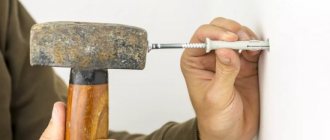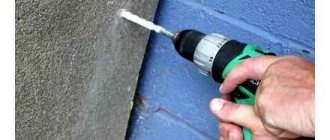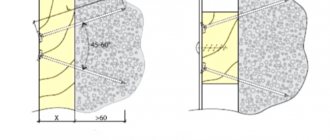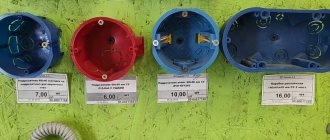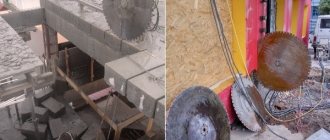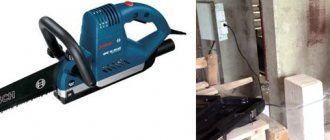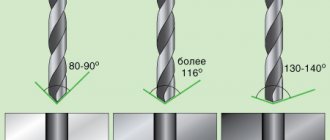How to drill a hole in a large diameter concrete wall?
We insert a blade into the hammer drill, switch it to jackhammer mode without drilling and knock out the jumpers between the drilled holes. You can place a spatula in the center of the circle and chisel away any excess brick or concrete. If the shoulder blade is short and goes through the wall
does not penetrate, you can chisel the brick on the other side
of the wall
.
Interesting materials:
How long does silicone sealant take to dry? Silicone sealant is waterproof, how long does it take to dry? How many 120 nails are in 1 KG? How many 120 nails are in a kilogram? How many 150 nails are in a kilogram? How many cans of foam are there for one window? How many white bricks are there in a square meter? How many white bricks are in a pallet? How much concrete is in 1m3? How much concrete is in one cube?
Required Tools
What types of drills are there?
Concrete structures have increased strength and contain particles of crushed stone, which is why they cannot be destroyed with a conventional drill bit.
During the process, the drill encounters areas of increased hardness and the work stops.
Therefore, impact drills or hammer drills are used for drilling.
But in domestic conditions, for a small amount of work, purchasing expensive tools is not advisable; a hole in concrete can be drilled without a hammer drill. At home, you can get by with a simple dorel with special attachments:
- Steel punch - used when a regular drill gets stuck in particularly strong areas. It is a special rod with a pointed end of increased hardness. The punch is inserted into the hole being made and hit with a hammer, crushing the most dense areas. You can also use a long drill with a Pobedit tip as a punch.
- Pobedite drill – has a tip made of metal, which is particularly durable. These drills are optimal for working on concrete. The drill tip is made of an alloy of carbide - tungsten and cobalt.
- Diamond-coated drill bit is a highly effective attachment for drilling crushed stone and beta. Diamond drills are installed on a conventional drill or on an impact drill when working with vibration turned off. The cost of diamond drills is quite high, so purchasing them for occasional use is not advisable.
- Tungsten carbide-coated bits are used exclusively with high-power drills. In everyday life, crowns with a diameter of 120 mm are used; professionals use attachments with a larger diameter. For concrete, experts recommend using crowns with separately soldered teeth. If there is iron reinforcement in the thickness of the wall, it is not recommended to use crowns, as the teeth will break off.
- KS-crowns - crystalline diamond particles are applied to their edges, allowing for drilling in concrete structures.
IMPORTANT. To obtain holes with a diameter of more than 12 mm and a depth of more than 110 mm, it is not recommended to use a conventional drill. Without a hammer drill or impact tool, it is impossible to make a large hole in concrete or a through hole.
A little about the structure of the drill and installation of the drill
A classic drill consists of a power cable, a button, a capacitor wire, a reverse, brushes and springs, an armature, a stator, a gearbox and a chuck, bearings, a key and mounting screws. A correctly inserted drill improves the quality of drilling and can make it safer.
The first thing you should check when starting to work with a drill is whether there is any contamination on the drill itself. A rag will be an excellent assistant in cleaning drills. If the drill is loosely secured, there is a risk that it will fly out and injure the technician. Accordingly, it is necessary to immerse the drill as much as possible into the chuck (all the way!).
Under no circumstances try to “extend” the drill by incompletely immersing it in the chuck!
It is important to ensure that the drill in the tool is secured strictly along the axis. If this rule is not followed, drilling in concrete will be performed poorly, the shape of the hole may be unpredictable, and the cause of all these misunderstandings will be the elementary effect of drill beating.
Features of the work: advice from experts
Drilling a concrete wall with a simple drill has some nuances:
- The drill cannot be stopped while the drill is in the wall: the tip will get stuck and it will be difficult to remove it. The pressure on the key stops only after the drill is removed from the wall.
- During operation, the drill is periodically wetted so that it does not overheat.
- Do not press too hard on the drill: this will lead to deformation of the rod or destruction of the chuck.
- If a hole is drilled through a layer of plaster, first study the layout of communications. Otherwise, there is a risk of damaging, for example, hidden electrical wiring.
IMPORTANT. Do not drill through the decorative finish of the wall!
Compliance with work technology and safety rules when drilling holes in concrete with a conventional drill will help not only to avoid the involvement of highly paid specialists, but also to avoid injuries.
Preparation and process
Before drilling into a concrete wall with a conventional drill, you need to inspect the tool, check its serviceability and insert the nozzle completely until it stops.
Then you will need to inspect the wall and check if wires and cables will be touched. If possible, you should also make sure that there is no reinforcement if you are using a non-diamond drill. If there may be reinforcement along the drilling path, it is necessary to prepare a metal drill.
Before you start drilling, you need to protect yourself: wear thick gloves, safety glasses, and insert earplugs or headphones.
Drilling a hole
First you need to mark the location and select the depth. Modern models usually have special limiters. If they are missing, you can put a mark on the nozzle.
A few examples will help you better understand how deep you need to drill: for a picture or a light shelf, 2.5 cm deep is enough.
Drilling with special attachments Source minemegashop.ru
When installing the dowel, the hole should be several millimeters longer. When the dowel is inserted, dust will form, which will take up extra space.
A hole is drilled in a brick or concrete wall in several steps:
- Having chosen a place and made a mark, attach the tip of the nozzle and turn on medium speed without turning on the impact mode.
- After passing a few millimeters, you need to increase the speed and turn on the shock mode. This will allow you to continue drilling smoothly without deviating due to strong vibrations.
- Every 10-15 minutes you need to stop and let the engine cool. You can continue only when the tool has completely cooled down.
- If desired, the nozzle can be regularly moistened with water so that the metal does not bend or overheat.
Working with a punch will require more time and labor. The tool itself is necessary when the wall is too hard and the drill cannot cope.
Using a limiter Source mebel-expert.info
How to drill wood surfaces with a drill
Wood is the easiest material to drill. But there are also certain features of the technological process that must be observed so as not to spoil the surface and not to break the equipment. Speed parameters depend on the type of wood covering. Loose samples are easy to drill. The following types of wood equipment can be distinguished:
- flat or feather;
- twisted, they are also single-spiral;
- crowns, also called core drills;
- cylindrical nozzles of the Forstner type.
Select a drill. As a rule, for small holes (less than 1.2 cm), metal equipment is used; if you need a larger diameter, you will have to fork out for a specialized wood drill.
For larger holes it is necessary to use annular crowns. Forstner-type crowns are ideal for drilling blind areas.
Particular attention must be paid to drilling the timber. Despite the fact that it is very convenient to fix, its thickness often becomes a negative factor that complicates the work. If the timber is of a standard size, then, as a rule, drills up to 25 mm are used. The drilling process always takes place at low speeds.
Features of drilling
When using a drill, it is important to select equipment and a drill with the necessary technical parameters. It is recommended to use an electrical device with a speed controller and an additional shock mode.
The use of a side handle speeds up drilling and reduces the load on the operator; a drilling depth regulator will not be superfluous.
Drill device and drill installation
The design of the drill uses a commutator electric motor of alternating current. The design of the motor includes a speed controller located on the power button. To reduce the rotation speed and increase the torque, a gearbox is used; there is a tool with a 2-speed gearbox.
A cam chuck is attached to the output shaft of the gearbox; a chuck with a latch is used in rotary hammers. The hammer drill gearbox is equipped with a separate unit that ensures the formation of translational and rotational movement of the drill.
Before drilling into a concrete surface, the drill must be secured. The tool is placed in the chuck, the cams ensure the alignment of the drill and the axis of the chuck. The drill is placed inside the chuck for the entire length of the shank; lengthening the working part of the tool by pulling the shank out of the chuck is prohibited. To tighten the chuck, use a wrench (included with the drill).
Power selection
To make holes in concrete surfaces, a tool with a power of at least 600 W is required. The rotation speed is selected depending on the diameter of the drill and the characteristics of the material being processed. The worker independently selects the speed, reducing the emission of dust into the air and reducing the likelihood of wall fragments breaking off when drilling a hole.
Errors when working with a drill
Main mistakes when operating an electric drill:
- Do not hold the equipment by the chuck when working. Protective gloves and clothing should not sag or have loose parts, as there is a risk of material wrapping around the rotating drill.
- Do not point the tool at an angle or apply excessive force as the worker may fall from the stepladder or ladder and be injured.
Choosing a tool and working with it
When choosing a tool to drill a hole, you should understand that your work depends on it. A good drill accurately drills into a concrete wall or other required material, simplifying the drilling process, while a bad one will require a lot of time, may not cope with the task, or will complicate it. What you need to pay attention to when choosing a drill:
- Is it possible to change the drilling speed? – this point is important, since correction of the speed mode will ensure accurate operation of the drill, helping it not to damage the surface.
- Is it possible to hammer drill and adjust the depth? – impact drilling can be used on problem areas, softening them.
- Is it possible to hold the drill with both hands? – a drill is not a light tool and therefore preference should be given to models that are equipped with handles.
- Is the tool's power sufficient for your job?
Having decided on a drill, before starting work you need to get the hang of holding it. To do this, you should take the drill in one hand, like a pistol, and place the other hand on the handle of the tool (if it is not intended by the design, the hand is placed near the chuck). It is necessary to hold the drill in your hands strictly horizontally, so that the hole does not turn out distorted or at the wrong angle. Wait until the drill reaches ambient temperature before turning on the drill. Sudden temperature changes can cause condensation. If you decide to rest while working, unplug the tool.
Step-by-step instruction
Drilling diagram
How to make a hole in a concrete wall or ceiling slab without a hammer drill and other similar tools?
First you need to prepare everything.
Despite the presence of a special drill, work on a concrete wall is carried out taking into account the recommendations of specialists.
An incorrect approach can lead to tool breakage and partial destruction of the wall. Before starting work, prepare the following set of tools and materials:
- drill of sufficient power;
- drill with pobedite (carbide) surfacing;
- punch - a metal pin of the required diameter;
- hammer or sledgehammer;
- vacuum cleaner.
The process of drilling concrete with a conventional drill is not fast, so the home craftsman should be patient. Concrete dust eats into the floor covering, and to maintain cleanliness, it is recommended to cover the surface with newspapers. Periodically collect spilled particles with a vacuum cleaner. The sequence of work is as follows:
- An appropriate drill is installed on the tool. A drilling point is marked on the wall.
- Mark the drilling point, working at minimum speed, with light pressure. A small hole is made in the surface so that the drill does not slip during intensive actions.
- They go deep into the wall by 8-10 mm. The tool is held at a right angle while drilling. If misaligned, there is a risk of damage to the surface, tip or hands.
- Take out the drill and pierce the concrete with a steel rod.
- They go deeper into the wall another 10-15 mm and again finish off the concrete with a punch. After each stage of work, the drill is cleaned of concrete particles.
IMPORTANT. Each drilling stage should last no more than 30 seconds. The total duration of continuous drilling with a low-power tool is no more than 10-12 minutes. The motor of the tool must be cooled after each session, otherwise it will overheat and fail.
Drilling concrete with a diamond crown can be seen in the video:
